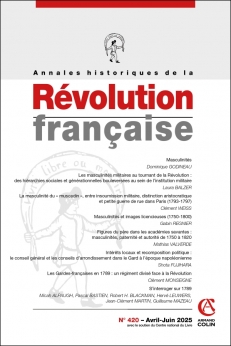
ANNALES HISTORIQUES DE LA RÉVOLUTION FRANÇAISE Nº 420 (2/2025)
Pour acheter ce numéro, contactez-nous
Recevez les numéros de l'année en cours et accédez à l'intégralité des articles en ligne.
L’armée française, sous la monarchie, ne permet pas l’élaboration d’un modèle masculin militaire unifié. Cette institution distingue une masculinité nobiliaire hégémonique parée de la raison et de la modération, qui s’incarne dans la figure paternelle de l’officier et qui s’oppose à celle des soldats issus de catégories sociales très modestes, comparés à des enfants téméraires mais indociles, que seule une autorité sévère et paternelle peut canaliser. Cependant l’âge des combattants peut modifier cette hiérarchie sociale masculine, l’expérience, la résistance psychique et physique étant l’apanage des vieux soldats, dominant de fragiles et jeunes recrues. Ces masculinités hégémoniques de l’officier noble et du vieux soldat sont cependant bouleversées par la Révolution qui émancipe les soldats, leur ouvre l’accès aux grades en imposant l’égalité entre tous les hommes, tous citoyens. Les jeunes hommes incarnent une nouvelle masculinité patriotique et enthousiaste, car les citoyens mâles doivent intégrer, dès leur plus jeune âge, leur nouvelle fonction militaire avec l’instauration progressive du service militaire. L’objectif de cet article n’est pas tant de décrire l’évolution des différents modèles masculins au sein de l’institution militaire, mais de comprendre comment des rapports de force se réorganisent, dans cette société masculine, en fonction de l’origine sociale et de l’âge des combattants, au gré des bouleversements politiques entre la fin de la monarchie et la période révolutionnaire.
The French army under the monarchy did not accommodate the development of a single unifiedmalemilitarymodel. This institution celebrated an hegemonic noble masculinity endowed with reason and moderation, and embodied in the fatherly figure of the officer, in contrast to soldiers from modest social categories regarded as reckless, unruly children controllable only by a stern, paternal authority. The age of the combatantswouldmodify this masculine social hierarchy, with experience and psychological and physical resilience as the prerogative of the old soldiers, who dominated the fragile, young recruits. Yet these hegemonic masculinities of the noble officer and the old soldier were to be transformed by the Revolution, which emancipated the soldiers, giving them access to higher military ranks by imposing equality between all men as all citizens. Young men represented a new patriotic and enthusiastic masculinity; male citizens had to assume their new military roles from a very young age, with the gradual introduction of military service. The aim of this article is not so much to describe the evolution of the different male models within the military institution, but to understand how the balance of power was reorganized in this male society according to the social origin and age of the combatants, following the political upheavals between the end of the monarchy and the Revolutionary period.